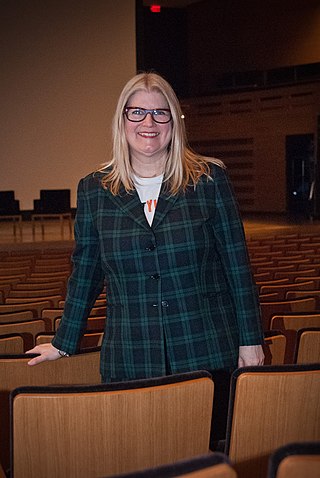Work
His work often combines sound, music, installation and film, a practice that he labels 'intermedia'. A member of the Artists Jazz Band from the late 1960s on (he played alto sax) [4] and the CCMC (Canadian Creative Music Collective) (1974-1991), and as one of the founding members of the Music Gallery, [5] he is known for his extended vocal techniques and sound poetry [6] which can be watched and listened to on You Tube. [7] In 1999, the Kelowna At Gallery held a retrospective of his work titled Nobuo Kubota: The Exploration of Possibility. A second exhibition titled Nobuo Kubota: Hokusai Revisited was held at Kelowna in 2010. [4] His current interest involves the development of a calligraphic style of notation for the depiction of sound which he calls 'Sonic Calligraphy'. [2] He has published two books, Phonic Slices and Deep Text (both 2001) with Coach House Books. [5]
His work is held in numerous collections including the National Gallery of Canada. [6] He was made a member of the Royal Canadian Academy of Arts. [8]
He received the Allied Arts Award from the Royal Architectural Institute of Canada. [2] In 2000, he received the Victor Lynch Stanton Award from the Canada Council. [9] He received the Governor General's award for the arts in 2009. [10] He also received a Doctor of Fine Arts Honoris Causa from the Ontario College of Art and Design (2011). [2]
From 1970 to 1998, he taught at OCAD University. [11]

Ontario College of Art & Design University, commonly known as OCAD University or OCAD, is a public art university located in Toronto, Ontario, Canada. The university's main campus is spread throughout several buildings and facilities within downtown Toronto. The university is a co-educational institution which operates three academic faculties, the Faculty of Art, the Faculty of Arts and Science, and the Faculty of Design. The university also provides continuing education services through its School of Continuing Studies.
Superflat is a postmodern art movement, founded by the artist Takashi Murakami, which is influenced by manga and anime. However, superflat doesn't have an explicit definition because Takashi Murakami does not want to limit the movement, but rather leave room for it to grow and evolve over time.
Shoshin is a concept from Zen Buddhism meaning beginner's mind. It refers to having an attitude of openness, eagerness, and lack of preconceptions when studying, even at an advanced level, just as a beginner would. The term is especially used in the study of Zen Buddhism and Japanese martial arts, and was popularized outside of Japan by Shunryū Suzuki's 1970 book Zen Mind, Beginner's Mind.

Wanda Koop is a Canadian interdisciplinary artist who lives and works in Winnipeg, Manitoba.
Henry Saxe is a Canadian artist who creates sculpture, painting and drawing.
Pierre Coupey is a Canadian painter, poet, and editor.
Ron Shuebrook is an American-born Canadian abstract artist living in Guelph, Ontario. He is a prominent teacher and administrator, as well as a writer.
David Charles Bierk was an American-Canadian realist painter known for working in the postmodern genre.
Jason Baerg is a visual artist, media producer and educator who works in drawing, painting, film and new media. He is a member of the Métis Nation of Ontario and developed and implemented the national Metis arts program for the Vancouver Olympics (2010). Baerg lives and works in Toronto.
The Art Gallery of Peterborough is a free admission, non-profit public art gallery in Peterborough, Ontario, Canada. A registered charity that depends on the support of its members, it was founded in 1974 by an independent board of volunteers. In 1977 it was given the Foster House by the City of Peterborough, a historical residence set in parkland beside Little Lake. In 1979 The gallery expanded to its current size of 11,000 square feet (1,000 m2) with the construction of its modernist wing designed by Crang & Boake architects. The collection presently numbers over 1,300 pieces. In addition to its permanent collection and exhibitions, the gallery offers many educational programs for adults and children. There is also a gift shop featuring a variety of works by local and national artisans.

Barbara Astman RCA is a Canadian artist who specializes in a hybrid of photography and new media, often using her own body as object and subject, merging art and technology.

Rudolf Bikkers, RCA is a Canadian painter, printmaker, educator and entrepreneur. Bikkers has had 23 solo shows and participated in 20 group shows in Canada, the United States, Europe, South Africa, China, Japan and Russia.
Glenn Lewis is a Canadian cross-disciplinary contemporary artist.
Yvonne Lammerich is a Canadian visual artist, curator and writer. Her work, largely in painting and installation, "articulates the simultaneity of experiencing the body's response as we navigate both real and projected space."
Catherine Marie Daley was a Canadian visual artist and educator located in Toronto, Ontario.
Gary Lee-Nova, born Gary Nairn, is a Canadian painter, printmaker, sculptor, and filmmaker.
Daniel Solomon is an abstract painter who uses intense, vibrant colour in his work, combined with complex, pictorial space, inspired by artists such as Jack Bush. Critics suggest that he and artists such as David Bolduc formed a bridge between the second and third generations of Toronto modernists or even form part of the third generation of Toronto abstract painters which includes artists such as Alex Cameron and Paul Sloggett.
John Scott was a Canadian multimedia painter, sculptor, and installation artist.
Tim Whiten is an American-born Canadian artist who works in the areas of sculpture, drawing, performance art and multi-media installations, using a wide range of materials. He also has been an educator.
Caroline Dukes was a painter and installation artist, born in Hungary but moved to Winnipeg, Manitoba in 1967. Today, she is considered a Manitoba artist.



